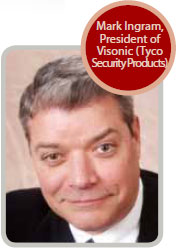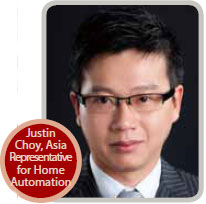“Clap on! Clap off!” It started with the clapper, a device first sold in the 80s that allowed people to turn their lights on and off with a burst of applause. Home automation (HA) has come a long way since the clapper and offers much more beyond lighting control.
The global HA and control systems market is estimated to grow at a CAGR of 16.1 percent from US$16.9 billion in 2011 to $35.6 billion in 2016, according to MarketsandMarkets research. Only one of the four segments of this market, namely luxury systems, will be significantly impacted by the recession, as it is relatively mature and will feel the greatest impact from the recession, according to ABI Research. Two other segments — standards-based mainstream HA systems and HA as a service — are so new that they have much room for growth starting from 2010. ABI Research found the number of HA systems — both professionally installed and DIY — will surpass 4 million units in 2013.
Since more devices nowadays are smart, connected and omnipresent, the smart home is no longer a concept or the privilege of a few. HA is coming to a home near you, at an incredible speed and increasingly affordable prices.
“Clap on! Clap off!” It started with the clapper, a device first sold in the 80s that allowed people to turn their lights on and off with a burst of applause. Home automation (HA) has come a long way since the clapper and offers much more beyond lighting control.
The global HA and control systems market is estimated to grow at a CAGR of 16.1 percent from US$16.9 billion in 2011 to $35.6 billion in 2016, according to MarketsandMarkets research. Only one of the four segments of this market, namely luxury systems, will be significantly impacted by the recession, as it is relatively mature and will feel the greatest impact from the recession, according to ABI Research. Two other segments — standards-based mainstream HA systems and HA as a service — are so new that they have much room for growth starting from 2010. ABI Research found the number of HA systems — both professionally installed and DIY — will surpass 4 million units in 2013. 
Since more devices nowadays are smart, connected and omnipresent, the smart home is no longer a concept or the privilege of a few. HA is coming to a home near you, at an incredible speed and increasingly affordable prices.
Affordability and usability have plagued home automation (HA). HA systems have not only been too expensive for most people to set up in the past, but they have been difficult to manage as well, said Craig Pyle, Director of Product Management, Vivint. 
“Some providers have made HA very expensive and very complicated,” said Mark Ingram, President of Visonic (a Tyco Security Products company). “Many manufacturers of HA products have come up with smaller, affordable packages that provide simple yet useful features. I also think providers tend to think about HA as large and complicated systems for the wealthy when they could sell a lot more if they ‘dumb it down.'” 
System integration and usability were difficult and complex. In the past, there were not many service providers offering bundled packages from security to entertainment, said Justin Choy, Asia Representative for Home Automation. Even for engineers, the integration could be thorny. Control devices could be problematic as well. Difficult to use and hard to understand devices retarded the development of more sophisticated HA because they give consumers a bad impression of how such technology works. 
“The two main causes underlying the slow uptake were the cost/ perceived value and the control unit,” said Andrea Baratta, MD of MTS Intercoms. “Things are slightly changing with IP technology, more reliable protocols and better management devices such as tablets and smartphones.”
Today, there are several factors driving the adoption of HA. “First, there has been a convergence of technologies that make home automation easy to use for almost everyone,” Pyle said. “Access control, lighting control, energy management and video are seamlessly integrated in a single platform. HA access through the Internet and mobile phones allow users control of their system without physically being in the home.”
GAME CHANGER
IP Adoption
 TCP/IP spread like virtual wildfire and ignited the possibility of HA going mainstream. “All security solutions are moving to IP technology,” said Marc Cuadras, Export Area Manager, Golmar. It simplifies network structure and reduces wiring equipment and installation costs by unifying traditional video, audio, data and control cables into one Cat 5 or fiber-optic cable. Besides more bandwidth, it supports remote control over the Internet and expandability. The networkagnostic approach in TCP/IP makes it easy to use any existing network infrastructure, thus allowing more HA devices to be connected to an IP network. Such integration capacity and the cost-effectiveness of sharing the same infrastructure demonstrate huge potential in the future.
TCP/IP spread like virtual wildfire and ignited the possibility of HA going mainstream. “All security solutions are moving to IP technology,” said Marc Cuadras, Export Area Manager, Golmar. It simplifies network structure and reduces wiring equipment and installation costs by unifying traditional video, audio, data and control cables into one Cat 5 or fiber-optic cable. Besides more bandwidth, it supports remote control over the Internet and expandability. The networkagnostic approach in TCP/IP makes it easy to use any existing network infrastructure, thus allowing more HA devices to be connected to an IP network. Such integration capacity and the cost-effectiveness of sharing the same infrastructure demonstrate huge potential in the future.
Management Devices
Better management devices with touch screens and user-friendly interfaces are innovations that turn what once seemed like sci-fi into reality. Instead of pushing button after button, touch screens allow customers interact directly with what is displayed. Also, customers can do so without any intermediate devices that would need to be held in their hands. Touch screens give customers easy access to HA systems and they work like magic.
Varied Requirements
Security and HA requirements differ by region and not only for communication frequencies and protocols. In some regions, home security is only used when no one is home while in others, it is only used when people are home, Ingram said.
 Usage of different HA products depends on the maturity and perception of the market. People in North America hear more about home area networks and HA than anywhere else in the world, except for Korea, said Bob Heile, Chairman of the ZigBee Alliance. Korea is similar and even ahead of North America in some ways. In these markets, people want to control things around them. In Europe, HA is seen as the central appliance for energy management instead of the general-purpose environment, Heile said. HA is targeted to specific things such as smart appliances, programmable thermostats or remote controllers. Some Asian countries such as India and China are starting to notice HA. Customers in China, for instance, still do not know how HA can help manage home living, since customers tend to associate HA with home theater systems, Choy said. “Customers need to know that HA systems include security, fire, gas detection, access control, home appliances, lighting control and HVAC control.”
Usage of different HA products depends on the maturity and perception of the market. People in North America hear more about home area networks and HA than anywhere else in the world, except for Korea, said Bob Heile, Chairman of the ZigBee Alliance. Korea is similar and even ahead of North America in some ways. In these markets, people want to control things around them. In Europe, HA is seen as the central appliance for energy management instead of the general-purpose environment, Heile said. HA is targeted to specific things such as smart appliances, programmable thermostats or remote controllers. Some Asian countries such as India and China are starting to notice HA. Customers in China, for instance, still do not know how HA can help manage home living, since customers tend to associate HA with home theater systems, Choy said. “Customers need to know that HA systems include security, fire, gas detection, access control, home appliances, lighting control and HVAC control.”
The requirements from wealthy and average homes are similar. They differ by services provided and amount of devices. In a high-end home, there are more peripherals.
The design and installation for stand-alone homes is very straightforward, while apartment buildings are more complicated. This is not only due to project size , but also the number of stakeholders involved. For apartments, building management, maintenance and construction teams need to be consulted.
In apartment buildings, where the intercom serves as the first line of security, security systems may be more focused on notification for each apartment unit. Stand-alone homes are more open and may install more intrusion detectors and alarms. However, as far as the end user is concerned, most of the services are the same.